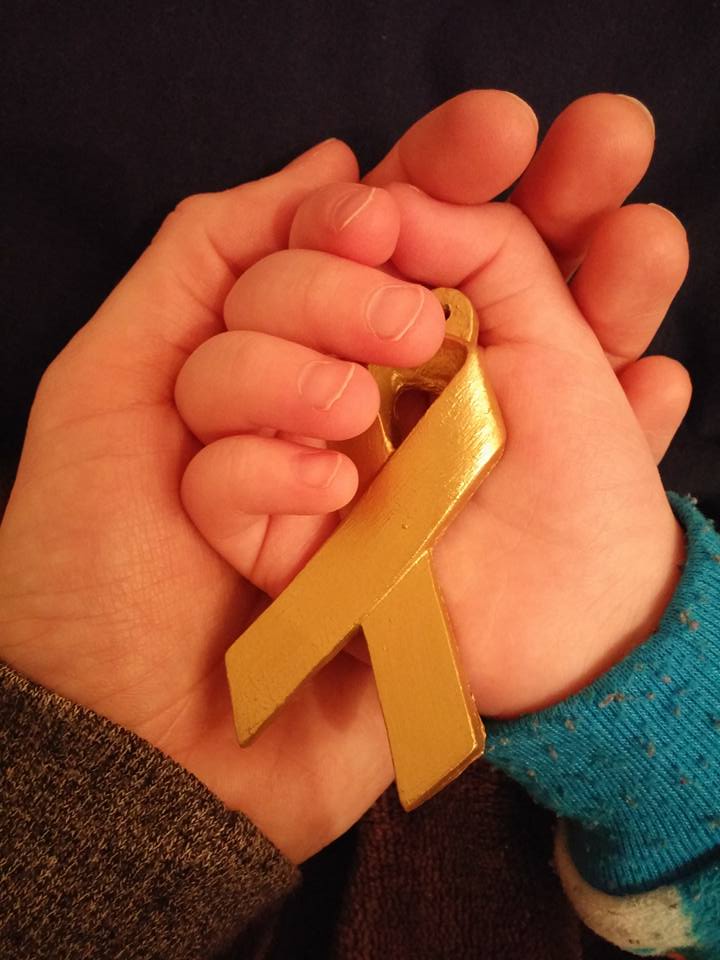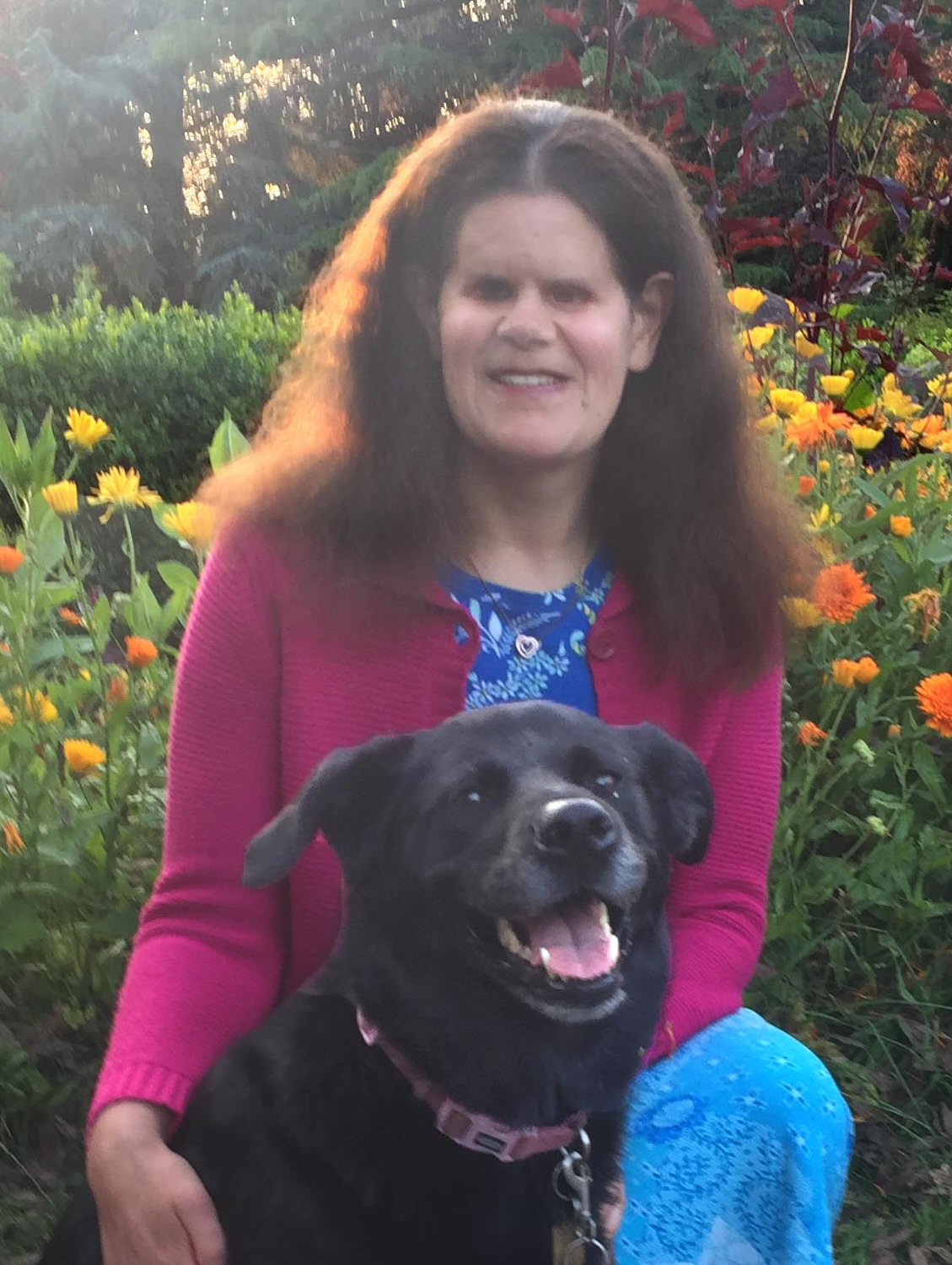Solidarity, Strength, and Synergy: The Gold Ribbon and the Global Fight Against Childhood Cancer
Monday April 1, 2024
The gold ribbon is the unifying symbol of childhood cancer. Worldwide, it celebrates the victory of each life saved, honours the memory of every precious child lost, and shines with hope of cure for all children. WE C Hope CEO, Abby White, explains four key reasons we support the gold ribbon campaign, and shares new gold ribbon merch designs you can buy to support our retinoblastoma community.
In the past 15 years, the gold ribbon has risen to prominence as the unifying global symbol of childhood cancer. Around the world, hospitals, support groups, nonprofits, advocates, families and communities promote this vibrant symbol of hope.
This ribbon celebrates the victory of each life saved, honours the memory of every precious child lost, and shines with hope of cure for all children with cancer worldwide.
Just as the red ribbon has done for AIDS and the pink ribbon for breast cancer, the gold ribbon has enormous capacity to increase awareness, support, and funds raised for childhood cancer causes.
Occasionally, a white or ivory/pearl ribbon is used to promote awareness of retinoblastoma. We are sometimes asked why World Eye Cancer Hope supports the gold ribbon campaign, rather than promoting a white ribbon uniquely for childhood eye cancer. This is an important question that cuts to the core of our vision, mission and values.
There are four simple reasons for our decision to promote only the gold ribbon, and discourage use of a white ribbon. Recognition, unity, collaboration, and practicality.
1. Recognition
The gold ribbon is known only for childhood cancer. In contrast, the white ribbon is best known for promoting peace, and remembering innocent victims of violent crime and conflict.
The great power and success of the red and pink ribbon campaigns is the instant recognition of those symbols as supporting AIDS and breast cancer respectively. The gold ribbon has vast potential to achieve the same impact for childhood cancer, while the white ribbon, already well known as a symbol of peace and innocence, is likely to cause confusion and dilute the messages we need to share.
For some individuals treated for retinoblastoma, as well as children and adults who carry the RB1 mutation without developing eye cancer, Rb is not the only cancer they experience. For example:
- Some children have an increased risk of leukaemia for a few years after chemotherapy.
- Rarely, RB1 mutation carriers develop a type of brain cancer called trilateral retinoblastoma.
- Osteosarcoma (a type of bone cancer), is one of the most common second cancers to affect RB1 mutation carriers, and occurs at a higher frequency during the pre-teen and teenage years.
We need to acknowledge these and other second cancers related to retinoblastoma, educate others about the risks and impacts, and promote research that supports earlier diagnosis and better patient care. This will be easier to do within the broad childhood cancer community than independently.
2. Strength in Numbers
Childhood cancer accounts for just 3% of all cancers, and retinoblastoma accounts for only 3% of childhood cancers. Due to those small numbers in the wider context of cancer, childhood cancer, and retinoblastoma especially, struggles already to gain attention and support.
No other subset of childhood cancer uses a different colored ribbon. Even the brain tumour and leukaemia communities focus on the gold ribbon to highlight the childhood cancer needs, rather than the ribbons promoting broad awareness of those cancers – which primarily affect adults.
Furthermore, September’s Childhood Cancer Month and the gold ribbon have been officially endorsed by the World Health Organization. WHO support of the red ribbon / December 1st World AIDS Day, and pink ribbon / October Breast Cancer Month, has been a major factor in success of these campaigns.
Promoting a white ribbon isolates our retinoblastoma community from the collective childhood cancer world. A fractured community that is already small hinders change-making recognition and action for both childhood eye cancer, and all children’s cancers.
3. Collaboration for Cure and Holistic Care
Collaboration is a core value of World Eye Cancer Hope. We encourage collaboration to:
- Increase knowledge and broaden understanding.
- Advance evidence based care
- Build sustainable solutions to the challenges that impact care and quality of life for patients, survivors, and their families.
We seek to work in partnership with all parents, survivors, medical professionals, researchers, organisations, institutions, donors and others who share our goal of advancing acute and lifelong Rb care worldwide.
While retinoblastoma is an eye cancer, it often has profound impacts on the individual and their family. Holistic care during treatment, recovery, and throughout life are vital to support physical and mental health, and overall quality of life.
The broad childhood cancer community includes multidisciplinary experts who, together, promote holistic care for the entire family and adult survivors. Some of these essential elements are lost if we focus only on retinoblastoma.
This is a key reason that the One Retinoblastoma World meeting is held in conjunction with the International Society of Paediatric Oncology World Congress rather than a professional meeting focused only on the eye.
In 2018, retinoblastoma became one of six Index Cancers selected by the World Health Organization to help focus efforts and evaluate progress in childhood cancer care. The campaign aims to increase global survival by 60% by 2030.
This coordinated action to enhance care is a global collaboration encompassing all childhood cancers. It offers great opportunity to highlight retinoblastoma and the unique needs and experiences of our community.
Promoting a white ribbon goes against this mission. We believe working together within the wider childhood cancer arena is vital to achieve best possible Rb care for all children, survivors and families,. We are stronger with a collective voice, and within a much larger community collaborating to achieve the shared mission of high quality holistic care for all.
4. Practicality
By being part of the wider childhood cancer gold ribbon campaign, we can reduce our costs. For example, small organizations can club together to buy gold ribbon pins and other items in bulk. The cost is lower than with individual small purchases, giving each organization more flexibility in how they use the items, and increasing sale profits.
A white ribbon appeals uniquely to the retinoblastoma community, while gold ribbon merchandise appeals to the wider childhood cancer community and general public. Outside our small Rb community, people generally understand and connect with “childhood eye cancer” more easily than “retinoblastoma” – a word many have never heard of.
So we have potential to generate more funds and also increase awareness of retinoblastoma within the childhood cancer community. Just as pink ribbons strengthen each breast cancer cause, so each gold ribbon strengthens our cause by working together and being part of the united voice.
Together, Everyone Achieves More!
We believe fully in the power of the team effort. So to promote change-making recognition, collaboration, and maximum fundraising potential, World Eye Cancer Hope fully endorses the gold ribbon as the sole unifying symbol of childhood cancer, including retinoblastoma.
We hope you will agree with our reasons for this endorsement. If you currently promote a white ribbon, we ask you to please carefully consider the potential impacts, and join us under the banner of the childhood cancer gold ribbon.
Buy Gold Ribbon Gifts & More at our TeePublic Store
We’ve added two new gold ribbon designs to our TeePublic store, including an Eye Fight Strong option that we particularly love. From fabulous apparel to creative accessories, you can make the gold ribbon shine in many places!
You’ll find a wide variety of apparel including men’s, women’s, and children’s sizes, as well as tote bags, coffee mugs, stickers, notebooks, cell phone cases, and much more. Visit our store today and sport your support for WE C Hope and gold ribbon awareness.
Every purchase you make supports our mission to improve diagnosis, care and lifelong support for all affected by retinoblastoma.
Use our exclusive TeePublic link to ensure a percentage of your ENTIRE purchase is donated directly to WE C Hope. This includes any item from TeePublic’s vast collection of unique and independent designs.
Throughout 2024, we are dedicating all proceeds from TeePublic sales to fund the One Rb World 2024 Conference – to be held 15-17 October in Honolulu, Hawaii, just before the 56th International Society of Paediatric Oncology World Congress. One Rb World brings together medical professionals, parents, survivors, and researchers, helping to grow the community, conversation and collaboration needed to create the best retinoblastoma care possible for everyone.
Shop now, shine bright, and share hope!
https://bit.ly/wechopeTeePublic
About the Author
Abby’s father was diagnosed with bilateral retinoblastoma in Kenya in 1946. Abby was also born with cancer in both eyes. She has an artificial eye and limited vision in her left eye that is now failing due to late effects of radiotherapy in infancy.
Abby studied geography at university, with emphasis on development in sub-Saharan Africa. She co-founded WE C Hope with Brenda Gallie, responding to the needs of one child and the desire to help many in developing countries. After receiving many requests for help from American families and adult survivors, she co-founded the US chapter to bring hope and encourage action across the country.
Abby enjoys listening to audio books, creative writing, open water swimming and long country walks.
You May Also Like…
Capture the Moment at One Retinoblastoma World 2024 in Hawaii
One Retinoblastoma World is community, conversation and collaboration for the best lifelong Rb care and support. Previous participants share why the event is so valuable. Rb survivor and WE C Hope CEO, Abby White, considers the many benefits of participating in person compared to attending online, and some ways we can travel “kuleana” to the conference.
Investing in Hope: The Quest to Fund Retinoblastoma Research
Research funding is vital to improve retinoblastoma early diagnosis, life and sight-saving treatment, family support, survivor care, and cancer prevention. But securing the funds for rare cancer research is very tough, often demoralising for researchers and clinician-scientists. Three retinoblastoma researchers share their experience, and two organizations helping to drive Rb research forward invite you to help.
Multicentre Research Collaboration: the Challenge and the Light
Multicentre research is complex. Challenges can arise in the process of bringing its many benefits to patients, families and professionals. In part 2/2 of this article, Rb survivor and WE C Hope CEO, Abby White, explores common challenges, with solutions for each, and how our childhood cancer community encourages healthy, successful collaborations.
United Against Retinoblastoma: The Importance of Global Data and Collaboration
Understanding how retinoblastoma affects children is critical to improve diagnosis, treatment, support and outcomes for all. Mattan Arazi, M.D and Ido Didi Fabian, M.D., MPH, world-focused ophthalmologists from Sheba Medical Centre, Israel, explore why global data and collaboration are so important in Rb research, and the knowledge, progress, and hope they are building for families and professional teams worldwide.









Leave a Reply
Want to join the discussion?Feel free to contribute!